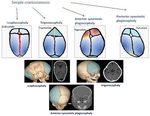Congress:
EuroSafe Imaging 2020
Keywords:
Performed at one institution, Diagnostic or prognostic study, Retrospective, Pathology, Dosimetric comparison, Developmental disease, Radiation safety, Dosimetry, Diagnostic procedure, CT, Paediatric, Neuroradiology brain, Head and neck, Action 7 - Radiation protection of children
Authors:
M. Gentile, A. GUIDI, P. Polidori, R. Calandrelli, A. Fidanzio, L. Bonomo, C. Colosimo
DOI:
10.26044/esi2020/ESI-10114
Background/introduction
Craniosynostosis or craniostenosis is one of the most frequent craniofacial malformations of the child, due to the fusion and premature closure of one or more sutures of the skull, with consequent deformity and compression of the brain structures.
Craniosynostosis is the process of premature sutural closure, taking place during a period of continuing brain growth, whereas craniostenosis is the result of this process.
The premature fusion of the suture inhibits skull growth perpendicular to the affected sutures, leading to skull base asymmetry, changes in craniofacial form and sometimes hydrocephalus.
The gold standard for the recognition of craniostenosis is volumetric CT.
The use of CT, although rapid in acquisition and executable mostly without anesthetic assistance, expose the newborn to a non-negligible dose of radiation. Various studies have shown that any irradiation in children is associated with a quantifiable risk of developing a tumor in old age and how this risk dramatically decreases with increasing age, especially during the first year of life.
The objective of the study is to reduce exposure to ionizing radiation, but still, completely identify the extent of the synostosis.



